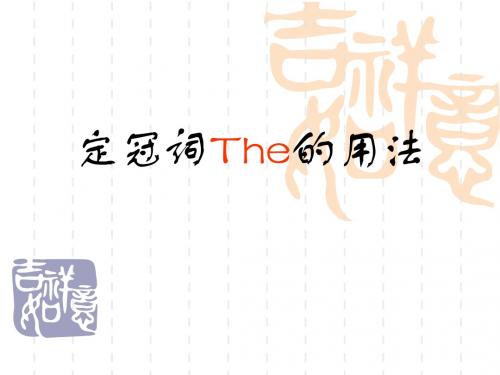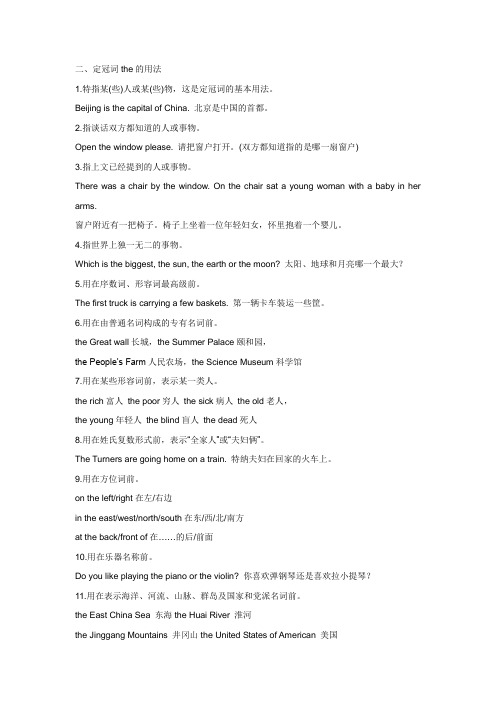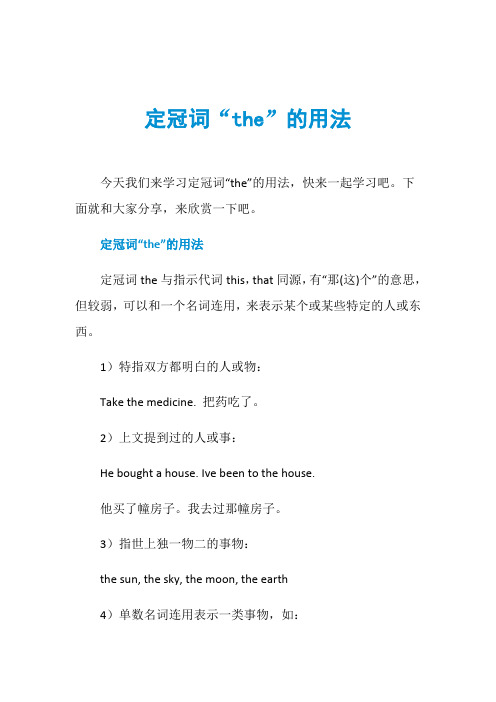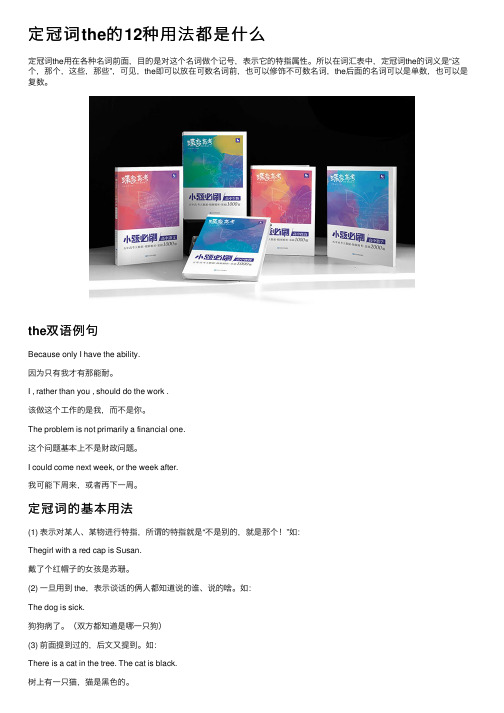定冠词the的用法精选
定冠词The的用法

7.用于江湖,海洋,海峡,山脉,群 岛,建筑物之前
Eg: The Great Wall
The Yellow River
The Pacific Ocean The Bird`s nest Stadium
8.用于有普通名词构成的专有名词前
Eg: The United States America The United Kingdom The stone Age
Eg: Open the window,please!
Can you give me the knife beside you?
3.用于世界上独一无二的事物
Eg:
The sun
The earth The moon
4.表示方位的名词前
Eg: The east The west
9.用于复数姓氏之前,表示全家
Eg: The Smiths The Blacks The Greens
10.用于西洋乐器和发明物之前
Eg: The piano The violin The compass was invited in China.
定冠词“the”的用法

二、定冠词the的用法1.特指某(些)人或某(些)物,这是定冠词的基本用法。
Beijing is the capital of China. 北京是中国的首都。
2.指谈话双方都知道的人或事物。
Open the window please. 请把窗户打开。
(双方都知道指的是哪一扇窗户)3.指上文已经提到的人或事物。
There was a chair by the window. On the chair sat a young woman with a baby in her arms.窗户附近有一把椅子。
椅子上坐着一位年轻妇女,怀里抱着一个婴儿。
4.指世界上独一无二的事物。
Which is the biggest, the sun, the earth or the moon? 太阳、地球和月亮哪一个最大?5.用在序数词、形容词最高级前。
The first truck is carrying a few baskets. 第一辆卡车装运一些筐。
6.用在由普通名词构成的专有名词前。
the Great wall长城,the Summer Palace颐和园,the People’s Farm人民农场,the Science Museum科学馆7.用在某些形容词前,表示某一类人。
the rich富人the poor穷人the sick病人the old老人,the young年轻人the blind盲人the dead死人8.用在姓氏复数形式前,表示“全家人”或“夫妇俩”。
The Turners are going home on a train. 特纳夫妇在回家的火车上。
9.用在方位词前。
on the left/right在左/右边in the east/west/north/south在东/西/北/南方at the back/front of在……的后/前面10.用在乐器名称前。
Do you like playing the piano or the violin? 你喜欢弹钢琴还是喜欢拉小提琴?11.用在表示海洋、河流、山脉、群岛及国家和党派名词前。
定冠词the的用法

定冠词the的用法下面店铺给大家总结定冠词the的常见用法:定冠词the与指示代词this,that同源,有“那(这)个”的意思,但较弱,可以和一个名词连用,来表示某个或某些特定的人或东西。
1、特指双方都明白的人或物Take the medicine. 把药吃了。
2、上文提到过的人或事He bought a house. 他买了幢房子。
I've been to the house. 我去过那幢房子。
3、指世界上独一无二的事物the sun, the sky, the moon, the earth4、单数名词连用表示一类事物the dollar 美元the fox 狐狸或与形容词或分词连用,表示一类人the rich 富人the living 生者5、用在序数词和形容词最高级,及形容词等前面Where do you live? 你住在哪?I live on the second floor. 我住在二楼。
That's the very thing I've been looking for. 那正是我要找的东西。
6、与复数名词连用,指整个群体They are the teachers of this school. (指全体教师)They are teachers of this school. (指部分教师)7、表示所有,相当于物主代词,用在表示身体部位的名词前She caught me by the arm. 她抓住了我的手臂。
8、用在某些有普通名词构成的国家名称,机关团体,阶级等专有名词前the People's Republic of China 中华人民共和国the United States 美国9、用在表示乐器的名词前She plays the piano. 她会弹钢琴。
10、用在姓氏的复数名词之前,表示一家人the Greens 格林一家人(或格林夫妇)11、用在惯用语中in the day, in the morning...the day before yesterday, the next morning...in the sky...in the dark...in the end...on the whole, by the way...。
定冠词“the”的用法

定冠词“the”的用法今天我们来学习定冠词“the”的用法,快来一起学习吧。
下面就和大家分享,来欣赏一下吧。
定冠词“the”的用法定冠词the与指示代词this,that同源,有“那(这)个”的意思,但较弱,可以和一个名词连用,来表示某个或某些特定的人或东西。
1)特指双方都明白的人或物:Take the medicine. 把药吃了。
2)上文提到过的人或事:He bought a house. Ive been to the house.他买了幢房子。
我去过那幢房子。
3)指世上独一物二的事物:the sun, the sky, the moon, the earth4)单数名词连用表示一类事物,如:the dollar 美元; the fox 狐狸;或与形容词或分词连用,表示一类人:the rich 富人; the living 生者。
5)用在序数词和形容词最高级,及形容词only, very, same 等前面:Where do you live? I live on the second floor.你住在哪?我住在二层。
Thats the very thing Ive been looking for.那正是我要找的东西。
6)与复数名词连用,指整个群体:They are the teachers of this school. (指全体教师)They are teachers of this school. (指部分教师)7)表示所有,相当于物主代词,用在表示身体部位的名词前:She caught me by the arm. 她抓住了我的手臂。
8)用在某些由普通名词构成的国家名称、机关团体、阶级、等专有名词前:the Peoples Republic of China 中华人民共和国the United States 美国9)用在表示乐器的名词之前:She plays the piano. 她会弹钢琴。
定冠词the的用法有什么用法

定冠词the的⽤法有什么⽤法1.特指某(些)⼈或某(些)事物。
2.指说话⼈和听话⼈都熟悉的⼈或事物。
3.上⽂提到过的⼈或事物。
4.表⽰世界上独⼀⽆⼆的事物。
5.⽤在序数词和形容词最⾼级之前。
6.⽤在某些形容词之前,表⽰某⼀类⼈或事物。
7.⽤在某些由普通名词构成的国家名称、机关团体、阶级、等专有名词前。
定冠词the的⽤法及例句1.特指某(些)⼈或某(些)事物。
例如:Give me the book. Did you hear the talk given by Mr Li?2.指说话⼈和听话⼈都熟悉的⼈或事物。
例如:Open the door, please. / Jack is in the library.3.上⽂提到过的⼈或事物。
例如:Yesterday John’s father bought him a new bike. The bike cost him 200 yuan.4.表⽰世界上独⼀⽆⼆的事物。
例如:The sun rises in the east and sets in the west.5.⽤在序数词和形容词最⾼级之前。
例如:Shanghai is the biggest city in China. / January is the first month of the year.6.⽤在某些形容词之前,表⽰某⼀类⼈或事物。
例如:The nurse is kind to the sick. / We should take good care of the old.7.⽤在某些由普通名词构成的国家名称、机关团体、阶级、等专有名词前。
例如:the People's Republic of China 中华⼈民共和国the United States 美国8.⽤在姓⽒复数之前,表⽰“某某⼀家⼈”,“某某夫妇”。
例如:the Browns, the whites等。
定冠词the的用法

定冠词the的用法定冠词“the”是英语语法中的一个重要概念。
它可以用于特定的名词前面,以指示这个名词所代表的事物或概念是已知或特定的。
在这篇文章中,我们将详细探讨the的用法,以及在什么情况下使用。
一般来说,the通常用于特定的名词前面。
这种名词可以是单数名词、复数名词、可数名词或不可数名词。
下面我们将分别详细讨论这些情况。
一、单数名词1.1 表示独一无二的事物当我们提到独一无二的事物时,通常需要使用the。
例如:- The sun sets in the west.(太阳落在西方。
)- The moon looks beautiful tonight.(今晚月亮很美。
)- The President of the United States will give a speech.(美国总统将发表演讲。
)在这些情况下,the可以被视为表示一个单独、确定和独特的事物或概念。
1.2 表示一个全体或特定群体当我们提到某个全体或特定群体时,也需要使用the。
例如:- The people of China celebrate Chinese New Year.(中国人庆祝中国春节。
)- The players on the field are very talented.(场上的球员非常有天赋。
)- The students in my class are very intelligent.(我班上的学生非常聪明。
)在这种情况下,the表示一个特定的集体或整体。
1.3 表示某个地方或场所当我们提到某个特定的地方或场所时,也需要使用the。
例如:- I'm going to the grocery store.(我要去杂货店。
)- The library is open until 10 pm tonight.(图书馆今晚开放到晚上10点。
)- Let's go to the park.(我们去公园吧。
定冠词the的12种用法都是什么

定冠词the的12种⽤法都是什么定冠词the⽤在各种名词前⾯,⽬的是对这个名词做个记号,表⽰它的特指属性。
所以在词汇表中,定冠词the的词义是“这个,那个,这些,那些”,可见,the即可以放在可数名词前,也可以修饰不可数名词,the后⾯的名词可以是单数,也可以是复数。
the双语例句Because only I have the ability.因为只有我才有那能耐。
I , rather than you , should do the work .该做这个⼯作的是我,⽽不是你。
The problem is not primarily a financial one.这个问题基本上不是财政问题。
I could come next week, or the week after.我可能下周来,或者再下⼀周。
定冠词的基本⽤法(1) 表⽰对某⼈、某物进⾏特指,所谓的特指就是“不是别的,就是那个!”如:Thegirl with a red cap is Susan.戴了个红帽⼦的⼥孩是苏珊。
(2) ⼀旦⽤到 the,表⽰谈话的俩⼈都知道说的谁、说的啥。
如:The dog is sick.狗狗病了。
(双⽅都知道是哪⼀只狗)(3) 前⾯提到过的,后⽂⼜提到。
如:There is a cat in the tree. The cat is black.树上有⼀只猫,猫是⿊⾊的。
(4) 表⽰世界上唯⼀的事物。
如:The Great Wall is a wonder.万⾥长城是个奇迹。
(5) ⽅位名词前。
如:thenorth of the Yangtze River长江以北地区(6) 在序数词和形容词最⾼级的前⾯。
如:Who is thefirst?谁第⼀个?Sam is the tallest.⼭姆最⾼。
(7) 在乐器前。
如:play theflute 吹笛⼦play thepiano 弹钢琴play the drum 打⿎(8) 河流、⼭脉、海洋前。
最全定冠词The的用法

The用法:定冠词the具有确定的意思,用以特指人或事物,表示名词所指的人或事物是同类中的特定的一个,以别于同类中其他的人或事物,相当于汉语中的“那个”或“这个”的意思。
它可以和单、复数名词,也可以和不可数的名词连用。
用在以辅音音素开头的词前读e,用在以元音音素开头的词前读ei ,在特别强调时读ei:。
1 加冠词的情况(1) 用以特指某(些)人或某(些)事物This is the house where Lu Xun once lived.(2) 用于指谈话双方都明确所指的人或事物Open the door, please.(3) 用以复述上文提过的人或事物(第一次提到用“a或an”,以后再次提到用“the”)Once there lived a lion in the forest. Every day the lion asked small animalsto look for food for him.(4) 用在序数词和形容词最高级前January is the first month of the year.Shanghai is the biggest city in China.(5) 表示世界上宇宙中独一无二的事物the sun; the earth; the sky; the world(6) 指由普通名词构成专有名词the West Lake; the Great Wall; the United States; the United Nations(7) 表示方向、方位in the east; in the front; in the bottom; on the right(8) 在海洋、江河、湖泊、山脉、海峡、海湾等地理名词前the Pacific Ocean; the Yellow River; the Tianshan Mountains; the TaiwanStraits(9) 在姓氏复数前,表示一家人The Bakers came to see me yesterday.The Greens are having dinner at home.(10)和某些形容词连用,使形容词名词化,代表一类人或物the poor; the rich; the sick; the wounded; the good; the beautiful(11)用在表示阶级、政党的名词前the working class;the Communist Party ofChina(12)用在the very强调句中This is the very book I want(13)固定用法a. the+比较级+the+比较级,表示越.....越......c. 某些固定的表达法in the morninggo to the cinemaall the year roundon the way to(14)表示演奏乐器时,乐器的前面要加theplay the piano; play the violin注:中国乐器名词前不与冠词连用:erhu(二胡)(15)the加单数可数名词可以表示一类人或事物The horse is a useful animal.注:像这类句子还有如下两种写法A horse is a useful animal.Horses are useful animals.(16)句型(v+sb+prep+the+身体某一部位)中要用the,而不用人称代词take sb by the armhit sb in the facebe red in the face注:如上等结构中,名词前要用the特殊用法(17)特指双方都明白的人或物Take the medicine.(18)与复数名词连用,指整个群体They are the teachers of this school.(指全体教师)They are teachers of this school. (指部分教师)(19)表示所有,相当于物主代词,用在表示身体部位的名词前She caught me by the arm(20)用在某些由普通名词构成的国家名称、机关团体、阶级、等专有名词前the People's Republic of Chinathe United States(21)用在某些习惯用语中at the same time 同时by the way 顺便问一句for the present 暂时go to the cinema 看电影in the end 最后in the dark 在黑暗中,不知道in the least 一点,丝毫in the open 在野外in the past 在过去in the long run从长远来看in the event of 万一in the morning 在上午in the way 挡道,碍事on the whole总体上on the other hand 另一方面on the contrary相反地out of the question不可能的(22)在中国传统节日前The Spring FestivalThe Dragon Boat FestivalThe Mid-autumn Festival注:不使用定冠词的情况:三餐前,四季,进行球类活动前不加the.2 用法口诀特指双熟悉,上文已提及。
- 1、下载文档前请自行甄别文档内容的完整性,平台不提供额外的编辑、内容补充、找答案等附加服务。
- 2、"仅部分预览"的文档,不可在线预览部分如存在完整性等问题,可反馈申请退款(可完整预览的文档不适用该条件!)。
- 3、如文档侵犯您的权益,请联系客服反馈,我们会尽快为您处理(人工客服工作时间:9:00-18:30)。
、定冠词the的用法1.特指某(些)人或某(些)物,这是定冠词的基本用法。
Beijing is the capital of China. 北京是中国的首都。
2.指谈话双方都知道的人或事物。
Open the window please. 请把窗户打开。
(双方都知道指的是哪一扇窗户)3.指上文已经提到的人或事物。
There was a chair by the window. On the chair sat a young woman with a baby in her arms.窗户附近有一把椅子。
椅子上坐着一位年轻妇女,怀里抱着一个婴儿。
4.指世界上独一无二的事物。
Which is the biggest, the sun, the earth or the moon? 太阳、地球和月亮哪一个最大?5.用在序数词、形容词最高级前。
The first truck is carrying a few baskets. 第一辆卡车装运一些筐。
6.用在由普通名词构成的专有名词前。
the Great wall长城,the Summer Palace颐和园,the People’s Farm人民农场,the Science Museum科学馆7.用在某些形容词前,表示某一类人。
the rich富人 the poor穷人 the sick病人 the old老人,the young年轻人 the blind盲人 the dead死人8.用在姓氏复数形式前,表示“全家人”或“夫妇俩”。
The Turners are going home on a train. 特纳夫妇在回家的火车上。
9.用在方位词前。
on the left/right在左/右边in the east/west/north/south在东/西/北/南方at the back/front of在……的后/前面10.用在乐器名称前。
Do you like playing the piano or the violin? 你喜欢弹钢琴还是喜欢拉小提琴?11.用在表示海洋、河流、山脉、群岛及国家和党派名词前。
the East China Sea 东海the Huai River 淮河the Jinggang Mountains 井冈山the United States of American 美国12.用在某些固定词组中。
all the same 仍然all the time 一直all the year round 一年到头at the age of 在……岁时at the beginning of 起初; 开始at the end of 在……的尽头/末尾at the entrance of 在……门口at the foot of 在……脚下at the head of 在……的前面at the moment 此刻at the same time 同时by the side of 在……附近by the time 到时候by the way 顺便说catch the post 赶上邮班do the shopping/washing 买东西/洗衣服give...the message 捎口信给……go to the classroom 去教室in the end 最后;终于in the hat 戴帽子的in the middle of the day 中午in the morning/afternoon / evening 在上午/下午/晚上in the open air 在户外;在野外jump the queue 不按次序排队lead the way to 引路;指路look the same 看起来很像on the earth 在地球上tell the truth 说实话the day after tomorrow 后天the day before yesterday 前天the high jump 跳高the long jump 跳远the next day 第二天the next year下一年the people 人民the starting line起跑线三、不用冠词的情况1.在专有名词和不可数名词前。
I’m going to England next week for a holiday.下周我将要去英国度假。
2.可数名词前已有作定语的物主代词my, your, his, her等;指示代词this/ these, that/those; 不定代词some, any等及所有格限制时。
The letter is in her pocket. 信在她的衣袋里。
3.复数名词表示一类人或事物时。
My father and mother are teachers. 我的父亲和母亲是教师。
4.在星期、月份、季节、节日前。
The best time to come to China is in spring or autumn. 到中国来的最好时间是春季或秋季。
Today is Thursday, September 10th, Teacher’s Day. 今天是九月十日,星期四,教师节。
[注意] 如果月份、季节等被一个限定性定语修饰,则要加定冠词。
He joined the Army in the spring of 1982.他在1982年春季参军。
5.在称呼语或表示头衔的名词前。
Happy Teachers’ Day, Miss Zhao!Here it is, Mom!6.在学科名称、三餐饭和球类运动名称前。
I think Chinese is more popular than any other subject. 我认为汉语比其它学科更普及。
Can you play basketball? 你会打篮球吗?We are going to play football. 我们去踢足球。
[注意]I can see a football.(指足球,并非“球类运动”)Where’s the football.7.某些固定词组中不用冠词。
①与by连用的交通工具名称前by bus, by car, by bike, by train, by air/plane, by sea/ship②名词词组day and night, brother and sister, hour after hour, here and there③介词词组at home在家in surprise惊奇地at noon在中午on foot步行at night在晚上on duty值日at work在工作on time准时for example例如on business经商in school在上学on holiday在度假in class在上课on show展览in hospital在住院on top of在……顶部in bed在床上④ go短语go home回家go to bed上床睡觉go to school去上学go to work去上班go shopping/swimming/boating/fishing去买东西/游泳/划船/钓鱼介词in的用法悬赏分:5 |提问时间:2011-2-16 09:35 |提问者:天天被被oh其他回答共2条1.(表示位置)在…里面; 在, 于; 在…部位上I could feel the tension in the room.我可以感觉到房间里的紧张气氛。
They live in France.他们住在法国。
2.(表示时间)在…时期, 在…之后, 在过程中In her twenties and thirties she had had no difficulty getting jobs.她在二三十岁时找工作一点也不困难。
I cannot see you now, come back in half an hour.我现在不能见你, 半小时后回来。
3.(表示方向)往…内, 朝…方向I saw him go in the shop.我看到他走进了商店。
4.(表示状态)处于…之中, 在…情况下Martin was in his pyjamas.马丁穿着睡衣。
They were living in terrible poverty.他们生活在极度贫困之中。
5.(表示方式)用, 以, 按, 乘, 以…形式They were speaking in Italian.他们在讲意大利语。
They went up in the lift.他们乘电梯上楼了。
6.(表示原因)由于, 为了He went in fear of his life.他为自己的性命担忧, 所以走了。
7.(表示领域, 范围)在…以内It is not in my power to do that.做那事非我力所能及。
8.(表示结果)当做, 作为What did you give him in return?你给他什么作为报答呢?9.(表示目的)为了They set off in search of the lost child.他们出发去寻找走失的孩子。
10.[表示职业、活动等]从事于,参加11.[表示数量、程度、比例]按,以;从…中12.[表示品质、能力等]在…之中;在…身上I don't think he had it in him.我认为他没这个本事。
回答者:pwx1230|二级| 2011-2-16 09:381.(表示位置)在…里面; 在, 于; 在…部位上2.(表示时间)在…时期, 在…之后, 在过程中3.(表示方向)往…内, 朝…方向4.(表示状态)处于…之中, 在…情况下5.(表示方式)用, 以, 按, 乘, 以…形式6.(表示原因)由于, 为了7.(表示领域, 范围)在…以内8.(表示结果)当做, 作为9.(表示目的)为了介词on的用法悬赏分:0 |解决时间:2008-1-5 20:13 |提问者:独步紫云介词on表示关于---时应怎样用??最佳答案ONabbr.1. =Old Norse 古挪威语2. =OntarioonKK: []DJ: []prep.1. 在...上He laid a hand on my shoulder.他把一只手放在我肩上。
2. 以...支持,挂在...上;以...为轴There is a picture on the wall.墙上有一幅画。
3. 朝,向4. 靠近,在...旁,沿着She stood on my left.她站在我左边。
5. 在...的时候,在...后立即He jumped with joy on hearing the news.他一听到这个消息就高兴得跳了起来。
